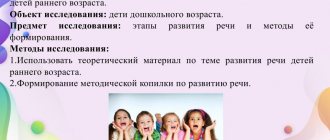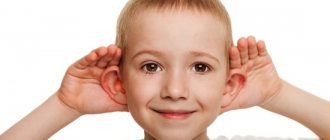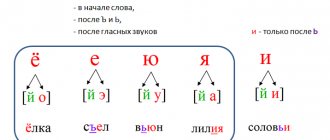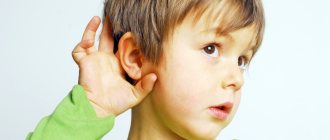Passive and active vocabulary of a child
The vocabulary of any person consists of a passive and active part. The active stock includes those words that we use in our spoken speech and writing, the passive stock includes words that we know (we recognize by hearing or reading), but do not use ourselves.
It’s exactly the same with kids, and you’ve seen this more than once. There can be a lot of examples: you ask the baby: “Where is grandma?”, and he points his finger at the corresponding family member or moves and fixes his gaze on her - this means that the word “grandmother” is already in his passive vocabulary, despite that he doesn't say it yet.
Stages of work on developing children's active and passive vocabulary. Part 1
Svetlana Shumakova
Stages of work on developing children's active and passive vocabulary. Part 1
The development of the lexical side of speech is an important section of speech therapy work . The child must be able to recognize and understand the words that he hears, be able to select words for statements and use them correctly both in structural and semantic connection . Based on their meaning and grammatical features, words in a language are grouped into lexico-grammatical categories - parts of speech , some of which convey real lexical meanings, while others are only grammatical and are used to connect words in a sentence or to connect sentences. In addition to their actual lexical meaning, words have an emotional and expressive connotation.
When working on the development of the lexical side of speech, a speech therapist needs to take into account the multifaceted nature of the word and provide for several areas of work on them :
- work on expanding the volume of the vocabulary in parallel with expanding ideas about the surrounding reality;
- clarify the meaning of words ;
- work on developing the ability to distinguish between correctly and incorrectly pronounced words ;
- work on the development of a passive vocabulary , i.e., the accumulation in memory of words that a child can recognize and understand;
- work on systematizing the words that the child has, grouping them according to different criteria;
- work on matching , comparing words according to their lexical meanings (synonyms, antonyms)
;
— work on semantic compatibility of words;
- work on activating the dictionary , improving the word , translating a word from a passive to an active dictionary .
The process of mastering words in your native language occurs in stages . It is based on teaching preschoolers how to compose various types of sentences. The types of proposals are constantly becoming more complex. At the first stage of speech development, the child uses only individual words - this is the stage of a one-word sentence . The main task of speech therapy at the first stage of training is the accumulation of passive vocabulary . Children are asked to remember the names of their toys (doll, car, pyramid, etc.)
;
body parts (legs, arms, head, etc.)
;
items of clothing (coat, hat, shirt, etc.)
;
household items that the child comes into contact with daily (table, chair, cup, spoon)
;
individual names of objects and phenomena of life around him (water, earth, sun, flowers)
names of animals that the child
often sees .
The passive verbal dictionary should consist of the names of actions that the child performs himself (sleeping, eating, sitting, walking, jumping, playing, washing, dressing, undressing, watering, speaking, drawing). In addition, the child should know the names of actions that people close to him perform, but this dictionary may be limited to the names of only those actions that the child has repeatedly observed (reading, writing, washing, ironing, etc., or actions performed at home, on street (a car is driving, a plane is flying, leaves are falling, the phone is ringing)
.
In children with speech underdevelopment, the verbal passive vocabulary is smaller than the subject passive vocabulary . Therefore, if children know the names of objects, some animals, etc., then it is necessary to begin to teach them to understand the names of actions, as well as to understand the questions asked about the actions taking place: where? Where? What? where? to whom? for whom? When working with non-speaking children, it is not recommended to overload their passive vocabulary with words with an abstract meaning or generalizing words .
Materials for conducting classes can be toys, household items, clothing, dishes, food, etc.
A crucial moment in speech therapy work with children at stage I will be the creation of the need to imitate the words of an adult . Imitative speech reactions can be expressed in any sound complexes ( "am"
,
“mu”
,
“ko-ko”
).
Activating children's speech , or inducing speech imitation, should be closely related to practical activities, to play, to a visual situation, which is achieved under various but mandatory conditions : emotionality of contact with the child, a certain level of understanding of speech, stability of attention, the presence of imitative motivation .
To achieve the desired effect in activating imitative speech activity, one must start with the development of imitation in general : “Do as I do”
.
As a result of speech therapy work at the first stage of oral speech formation, children must learn to passively correlate objects and actions with their verbal designation . Passive vocabulary should consist of the names of objects that the child often sees ; actions that he himself performs or those performed by persons familiar to him; some of their states (cold, warm, hot)
.
Children should develop a need to imitate the words of an adult . Verbal imitative activity can manifest itself in any speech-sound expressions, without correction by adults.
Stage II of training involves the following main tasks:
1) teach children to correctly construct two-word sentences like : appeal + command; command + name of the subject;
2) learn individual everyday phrases ;
3) pronounce the stressed syllable of the word ;
4) expand the scope of understanding someone else’s speech.
One of the main conditions for speech therapy work with children who do not have access to basic inflection is the implementation of activities that contribute to the development of the semantic side of speech . Only what the child understands and is present in his impressive speech is translated into expressive speech.
It is advisable that children at this stage learn to distinguish between the number of objects (many, few, one, size (large - small, taste (sweet - salty), as well as their spatial arrangement, if these objects are in places familiar to the child. If the child persistently does not correlates a color or size with their verbal designation , then we must limit ourselves to comparing objects by their color or size, postponing the work of memorizing the names of colors to a later date.
Particular attention should be paid to teaching children to distinguish between the singular and plural grammatical forms of some nouns and verbs. At this stage , it is recommended to use the following speech therapy techniques: naming objects or subject pictures; request to pass, take, give away an item; finishing phrases started by a speech therapist with visual support on an object or its image; naming actions in the imperative mood. A necessary condition is for children to repeatedly pronounce the words .
As a result of the second stage of training, children must learn the place of stress in memorized words , reproduce the rhythmic-intonation structure of two- and preferably three-syllable words . In understanding speech, children must correlate objects with their function, named by an adult, recognize familiar objects by describing their main features, be able to demonstrate or in an accessible verbal form answer questions about indirect cases posed by a speech therapist to the details of plot pictures.
At the third stage of training, children must learn to coordinate the subject and predicate in the third person singular and plural of the present indicative mood. The stock of these everyday colloquial verbs is small, but children must correctly use some of them in several forms: infinitive, imperative mood and in the indicative mood of the present tense of the 3rd person singular and plural.
Work on the syllabic structure of words ends with the assimilation of the rhythmic-syllabic pattern of two- and three-syllable words . Violations of sound pronunciation are acceptable. Understanding speech includes understanding some grammatical forms of words , simple stories, and short fairy tales.
Speech therapy work at stage IV is aimed at teaching children to compose simple sentences of various types from 3-5 words . In this case, it is necessary to teach how to express the connection between words using endings with the correct phonetic design. In constructions consisting of indirect cases with prepositions, children can omit prepositions. With the help of questions, the speech therapist corrects the order of words in a sentence , making sure that the child, when composing a sentence, uses the verb in the required form, matching the number and person with the noun.
From the fourth stage , children begin to learn , which will continue in subsequent stages . The formation of grammatical forms of nouns and verbs, and then other parts of speech, is ensured by the fact that different forms of the same word are contrasted with each other. This opposition requires a certain vocabulary and a certain sequence of grammatical oppositions.
Based on the data of speech ontogenesis, it is recommended to begin intensive training in inflection when accumulating 100-150 words-names of objects and about 40-50 names of actions (verbs)
.
Children's attention should be paid to the ends of words , when changing which children retain the intonation-rhythmic pattern, i.e. the number of syllables in the word .
If at the first stages of completing tasks, children’s one-word answers are quite acceptable , then later the child is required to pronounce the entire sentence with correct grammatical format. Children with general underdevelopment find it difficult to formulate the second, verb-dependent word than the first, for example: “The girl is chasing the goat with a rod (om)
».
The more children make sentences based on demonstrated actions, plot pictures, and answer questions in detail , the faster they will advance in their speech development . Therefore, outside of class, it is necessary to use any subject situation, any subject of a picture, about which you can ask: who (what)
This?
what is he /she
doing? how? to whom? Where? Where? etc.
At stage IV, work on the syllabic structure of words the words being practiced , taking into account the fact that the sounds that make up these clusters are already pronounced correctly. The practiced combinations of consonant sounds are then introduced into words , which the children must pronounce syllable by syllable.
The work of memorizing poetry is important It should start with verses in 2 lines with obligatory support on objective or simple plot pictures. When memorizing poems, you need to make sure you understand their content, for which you need to ask appropriate questions about the pictures.
If children have learned to answer questions, make sentences based on demonstrated actions and simple plot pictures, and have learned several couplets, you can begin teaching them the elements of retelling (2-4 sentences)
.
However, at this stage , learning coherent speech is not identified as an independent task due to a meager vocabulary .
As a result of speech therapy work at stage IV , children master everyday speech, i.e. it acquires a communicative function.
How to help your child develop vocabulary?
As you already understand, a child’s vocabulary begins with the passive part, and it, in turn, is formed from birth, therefore:
⇒ communicate with your baby. Talk not only to each other, but also purposefully with him. Pronounce words clearly, slowly, construct sentences as correctly as possible and do not “swallow” endings;
⇒ comment all around. Go to the kitchen with the baby, tell us what you will do now, and when you pick up any object, be sure to say its name, color, shape;
⇒ do not replace spoken language with TV or radio. A child needs a “living” environment to learn a language.
1. Active vocabulary in its infancy. It consists of onomatopoeia, babbling words and only a small number of common words. The meanings of words are unstable and undifferentiated.
2. Passive vocabulary is wider than active, but understanding of speech outside the situation is very limited. Phrasal speech is almost completely absent.
3. The ability to reproduce the sound and syllabic structure of a word has not yet been formed.
Children who are at the level of babbling speech need a lot of preparatory speech work before they begin to systematically master school subjects. Children can receive such preschool training in a preparatory class at a speech therapy school.
At school age, children who do not speak at all or who are at the level of babbling speech are relatively rare, in cases where the conditions of everyday communication are unfavorable (unfavorable speech environment, characterological characteristics of the child, etc.). Most often, by the age of 7-8 years, children reach the second level of speech development.
Second level of speech development
characterized by the fact that the speech capabilities of children increase significantly; communication is carried out not only with the help of gestures accompanied by babbling fragments of words, but also through fairly constant, although very phonetically and grammatically distorted, speech means. Here is a story by Vitya M., 8 years old, based on the series of paintings “Two Little Goats”.
“Izhaya Uska Dasha. Kozik dostret and comb badasya. Badaisi, badaisi, fill the water.” (There was a narrow plank lying down. The goats were coming towards them and began to butt. They butted, butted, and fell into the water.)
As can be seen from the example, the stock of commonly used words becomes quite diverse; it clearly distinguishes words denoting objects, actions, and often qualities. At this level, children already use personal pronouns, occasionally prepositions and conjunctions in elementary meanings. There is an opportunity to talk more or less in detail about well-known events, about family, about yourself, about comrades. But the underdevelopment of speech still appears very clearly or even sharply: ignorance of many words, incorrect pronunciation of sounds, violation of the structure of the word, agrammatism, although the meaning of what is being told can be understood even without a visual situation. So, instead of the word clean, the boy says: “He shakes off his coat”; the word janitor is replaced by the explanation “Such a guy sweeps the floor.”
Is learning languages good for speech?
Early learning of languages helps the development of a child’s speech if this process brings joy to parents and the baby. Therefore, you need to switch to the foreign language that you like best and know best.
Bilingual children begin to speak earlier from birth if both parents actively communicate with them.
“I often compare learning a second language to learning to swim,” Olga explains. If a child begins to master this activity at 3–4 months, then by the age of three he will already be able to swim perfectly independently. Then you can start teaching him how to ski, say. And if you start swimming at the age of three, then, of course, this process will take much longer, and parallel training in different sports can cause certain difficulties. It’s the same with languages.”
How many words should a child have in his active vocabulary?
The norms for the formation of the active vocabulary of a child of preschool and primary school age are as follows:
Thus, if a child normally pronounces no more than 10 words per year, then a child’s vocabulary at 3 years old is already about 1000 words. The vocabulary of a 5-year-old child is already about 2000 words, and the vocabulary of a 6-year-old child is about 3500 words. Don't panic if you suddenly find that your child is speaking fewer words than normal. Each child is individual and develops at his own pace. There are children who begin to speak closer to 2 years, but understand everything already at 1-1.5 years.
If you still have doubts or questions about your baby’s development, for your own peace of mind, consult a specialist. Good dynamics are provided by the inclusion of fun games to develop vocabulary, as well as finger exercises and palm massage. Positive emotions play a very important role: going to the zoo, water park and spending creative time together with parents.
Where can I get new words?
This, of course, is communication with parents and other close adults, and then added communication with other children. Interesting games and activities are also important - by expanding our horizons, we expand our vocabulary. What does it mean? At a very young age, every new sensation is recorded by a newly created neural connection in the baby's brain. Over time, everything that he has already learned and will snatch from the world around him in large quantities will begin to be reflected in words. Family traditions and holidays, walks and fairy tales.
“Everything around can become a source of enrichment for a growing person’s vocabulary. The main condition here is that the parent explains, names and shows. And in the future, he answered numerous questions,” explains Olga.
New sensations
Firstly, everything is tactile. Finger paints and various surfaces. Pet fur and rough tongues, sea and sand, pebbles and acorns, spruce branches and food. Plasticine and constructor. This is an inexhaustible source. And also sounds, smells and everything, everything, everything: music and new songs, for example, lullabies. The tastes of food and the smells of flowers - all this gives rise to new connections, new thoughts and requires words, stimulating the child.
Books, stories and games
Parents who read fairy tales and poems, invent nursery rhymes and sing songs are very helpful parents. Enthusiastic grandmothers, aunts, and older brothers and sisters also get involved. It is advisable to choose poems that are age-appropriate, and books with bright and clear pictures.
Travel and dating
Even if the baby just looks at everything and gurgles, new places and people will still awaken the dormant spirit of the explorer in him. The main thing on such trips is to tell and show the child everything, to let them touch what is interesting. And don’t be upset if a brick fence arouses more enthusiasm than a local landmark.
Brothers and sisters
In a large family, younger children usually speak better and start talking earlier because they often interact with older brothers and sisters.
Emotions
Find something that your child likes. A dog, a kettle and a slow cooker with lights, a pair of mom’s rubber boots - if a person is delighted, then you’re doing everything right. And it’s not far from the storm of emotions to its verbal expression.
Replenishing a child’s vocabulary with different types of parts of speech
Between one and three years of age, a child remembers the following:
- what are the names of your loved ones;
- what are the toys called?
- how household items are designated (food, dishes, hygiene items, etc.)
- natural phenomena;
- Seasons;
- easy names of plants and animals
A child’s vocabulary at this age has not yet been replenished with words that allow him to clearly express his assessment or emotions.
By the age of four or five, a child’s speech is already filled with a larger volume of words; he operates in a completely different way with concepts that have already been learned. What does a preschooler remember at this time:
- Labeling feelings (sad, happy, angry, etc.)
- Qualitative characteristics of objects (low, cold, light, etc.)
- How to correctly create a diminutive form of the word (son, daddy)
- Cognate words: (rook-rook; cat-kitten-cat)
By the age of five or six, a preschooler, as a rule, has already mastered about three thousand or more words; he knows the following:
- Time designation - days, weeks, hours, minutes, etc.
- Designation of space - right, left, sideways, etc.
- Simple and complex numbers
- The name of peoples, countries, the designation of social phenomena - labor, state, etc.
The child increases his stock of verbs and nouns most quickly, and adjectives more slowly. Since it is this part of speech that gives imagery to the conversation and saturates it, adults should pay attention to the descriptive and qualitative characteristics of objects and phenomena.
How do the first words come about?
Every mother eagerly awaits her baby's first words. As a rule, all relatives are involved in the waiting process: mom, dad or grandma - which word will come first? Usually, the winner in this fight is the one who most often stands over the child’s crib, looks carefully into his eyes and clearly repeats: “pa-pa” or “ma-ma.” As a result, the child pronounces the cherished word, and the whole family celebrates the historical event! The child is bathed in applause, and he, satisfied, continues to babble the magical sounds that have caused so many positive emotions in adults. If you continue in the same spirit - look into the child’s eyes, clearly pronounce new words and just as emotionally rejoice at each new one - you will certainly be surprised at the dynamics of your baby’s speech development.
“Why exactly “dad”, “mom” and “baba”? The sounds that make up these words are classified as labiolabial and labiodental. They are formed with the help of lips and voice and are easiest for a child. In order for the baby to also easily develop front-lingual, mid-lingual and back-lingual sounds, add the “horse” exercise: click happily with him,” explains Olga Ivanova.
Expanding your vocabulary with games and activities
How does the mechanism for enriching a child's vocabulary work? The child first hears the word, then understands what it means, remembers it, and only then begins to put it into practice. Almost all games and tasks for replenishing a child’s vocabulary are built on this scheme.
"Conductor". The game is built on the trust of an adult in a child. The companion asks the baby to accompany him. He closes his eyes and allows the baby to talk about everything he saw on a walk or at home. At the same time, the child is reminded that he needs to describe in as much detail and accurately as possible everything that he sees around him. An additional condition may be a request not to use the same words.
"Ball Game" Such exercises develop vocabulary and logic, generalize knowledge in the field of lexical groups. For example, the leader throws a ball, and everyone who catches it must name a new animal. Anyone who fails to do this is eliminated from the game. The same game can be played with the names of fruits, plants, vegetables, etc.
A variant of the same task is “who lives where?” The presenter throws the ball, asking: “Who lives in the ocean?”, “Who lives in a tree?”, “Who lives in the forest?”. Children answer in turns, inventing new inhabitants of the above-mentioned places. This exercise helps expand vocabulary and develop knowledge about the environment.
"Big small". In this exercise, the preschooler forms words with a diminutive meaning. The presenter says “mom”, the child answers “mommy”; The leader throws the ball, saying “table”, the child throws it back, saying “table”, and so on. This is not the easiest task, so the kids are given time to think about the answers.
Variant of the ball game “Edible-inedible”. The host names what you can eat, the children name what you can’t, and vice versa.
"Package". Each player receives an oral “package” (the presenter tells him in confidence what is in it). Participants describe their package so that others can guess what is in it
"Analogies". Children learn to derive “vocabulary formulas.” On the paper it is written: “a cat is an animal, a sparrow?” The child’s task is to assign the word to a specific thematic group.
“Finish the sentence.” The adult says the phrase, but does not finish it, and the child comes up with the ending. For example: “The cat jumped on the table, and...”; “Katya woke up, went to the window and saw...” The older the child, the more varied the stories will be. From such sentences, you can compose a whole fairy tale with your child.
Staging the sound “L” - independently and with a speech therapist
"Find the object." The adult thinks of a letter, the child finds objects that begin with it.
“Pick up a word.” The adult names the adjective, and the child looks for a noun for it. For example, the table and bread can be hard. Soft - a blanket and a cat. Then the rules change. The presenter says a noun, the participant selects an adjective. Sugar – sweet, crumbly; snow – wet, cold.
When choosing games and activities, you should take into account the child's temperament. Active preschoolers will enjoy playing ball; calm children will enjoy a descriptive exercise, when they need to analyze phenomena, name objects and talk about what they saw.
These and other games that you can come up with yourself will not only replenish your child’s verbal skills, but will also increase his self-esteem and make him have fun. Most of these tasks take no more than fifteen minutes and can be done on the way to the garden, on a walk, or at home. Experts recommend ending the game before the child himself asks for it. Then he will want to continue it tomorrow and the next day.










